Welcome to our new Kia
Simon takes delivery of the new Kia Sorento which he'll spend the next six months with. Will the big SUV justify its £36k price tag?
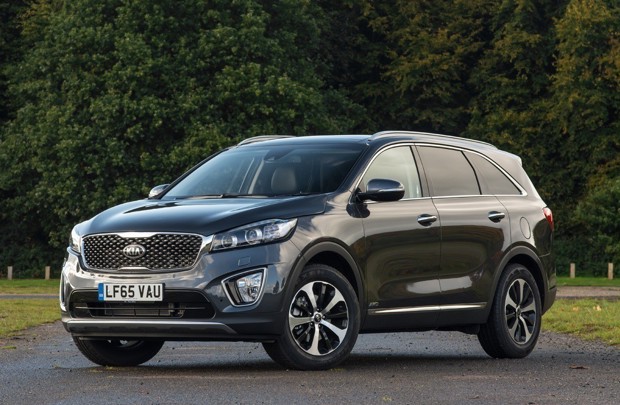
Date: 19 November 2015 | Current mileage: 1400 | Claimed economy 46.3mpg | Actual economy 40.4mpg
The second-generation Kia Sorento somehow passed me by. I remember attending the launch of the original, introduced in 2003, at an event in Sicily (not Sorrento). My driving partner on that occasion was Classics Editor Keith Moody, and despite me causing a panic on the second day leaving my house key and car key in my hotel room, leading to us running late for the flight home, I think we both arrived back with overwhelming memories of how impressive the car was for a Kia.
Change at the brand during the last 12 years has been at an astonishing pace. Most Kia models stand out for their elegant styling and cutting-edge features, while pricing is no longer aimed at those on a very tight budget. Its seven-year/100,000-mile warranty (introduced with the first Cee'd model in 2006) offers great peace of mind for customers buying new, as well as second owners.
So I was interested to take delivery of the third-generation Sorento launched in 2015. It’s grown in size as well as stature in the last 12 years. It’s longer, lower and wider than the previous version and all models now come with full-time all-wheel drive as well as seven seats.
It's perhaps not a true off-roader in the same way as a Mitsubishi Shogun, but with a centre differential lock and the right set of skills behind the wheel, the Sorento should be a great all-rounder regardless of terrain.

Posh features on our KX-3 include a panoramic sunroof. So you can see the rain better...
Our KX-3 variant is a step below the range-topping KX-4, but still comes with a vast list of standard features. These include a panoramic sunroof with automatic one-touch blinds, xenon headlights with automatic levelling, adaptive front lighting, eight-inch touchscreen satellite navigation with European mapping and TMC, an eight-way electric driver’s seat, alloy pedals, start/stop button and smart entry system, electric tailgate, an Infinity premium sound system, a seven-inch colour instrument display, lane departure warning system and speed limit information. I could go on...
This is on top of leather seats, automatic headlights and wipers, heated front and outer rear seats and reversing camera featured on the KX-2. Our manual version tips the scales at £35,845 on the road, with the KX-4 priced at £41,000 with its standard automatic transmission.
Some people asked on the media launch of this car if those prices were too high for a Kia. But customers don’t seem to think so. More than half of those purchased so far have been KX-3 and KX-4 grades.
Over the next six months, I’ll be making use of the car’s all-weather ability as a 30,000-miles-a-year driver, and will have occasion to use the third row of seats. It will be interesting to see, as I suspect, that brand image is less visible when it comes to SUVs, and whether the Sorento could lure customers away from more upmarket rivals.
The Sorento racks up the miles
Our Kia Sorento puts in some long distance drives during its first few weeks on our test fleet. Find out how it has fared.
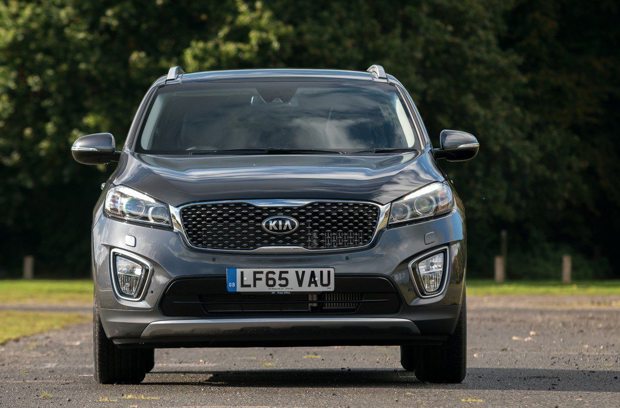
Date: 8 December 2015 | Current mileage 3481 | Claimed economy 46.3mpg | Actual economy 42.2mpg
Barely two weeks into my time with the Sorento and 2000 miles have been racked up. Much of it has been motorway mileage but the car has also spent time negotiating some tricky B-roads that you might expect to be well outside its comfort zone.
The motorway runs have been taken in its stride. It sits at a hushed 2000rpm in sixth gear, with very little noise intrusion into the cabin. The bonus is that, according to the trip computer at least, it seems to be within reach of the official combined fuel economy figure of 46.1mpg.
I’ve seen 43-44mpg, but haven’t had the chance to record an actual brim-to-brim consumption as I’ve only recently found the odometer reset function.
Of course, the function wasn’t that difficult to find, but it wasn’t immediately visible. It was in the many displays hidden within the TFT panel that forms the speedometer. There are several different screen options that can be individually selected using the buttons on the steering wheel, and gives the driver the choice of what information to view while helping keep the instrument panel uncluttered.
The TFT display can show a range of information about the Sorento
The Sorento has been surprisingly agile away from the motorway. It manages to retain its composure and feel capable far longer than you might expect for a high-sided two-tonne car.
None of this is in any way aided by the dual-mode steering offered in the Sorento. The default setting is normal, or the driver can engage a ‘sport’ mode with slightly greater resistance felt through the wheel when turning through reduced power assistance.
I’m usually sceptical of all these electronically variable driver assistance systems, whether they relate to steering or damper settings in the suspension and my view hasn’t changed with this one. The difference feels artificial. This isn’t the type of car that would appeal to driving enthusiasts.
The Sorento copes admirably with the standard settings and I begin to wonder if it's a case of adding it to help make the car feel even more generously equipped that rivals with a feature that no one had asked for.
Sorento's sleigh bell hasn't stopped ringing
The overall quality of the Kia Sorento is impressive. Apart from a metallic vibration somewhere in the rear passenger compartment.
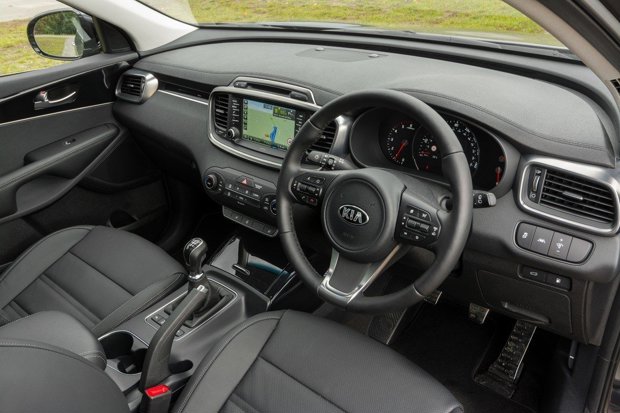
Date: 7 January 2016 | Current mileage 5518 | Claimed economy 46.3mpg | Actual economy 42.7mpg
We've established previously that we can see where the money has been spent in the £36,000 Kia Sorento KX-3. It's large, comfortable, seats seven, has four-wheel drive and a powerful diesel engine. It's well equipped and finished to a very high standard.
But ever since I took delivery in November, there has been a persistent metallic vibration coming from the rear of the car's interior. Up to now I'd been able to pass it off to passengers as Santa's sleigh bells, although it has been more annoying than the rhythmic chime of cantering reindeer.
It seems to be particularly intrusive on rough road surfaces or between 1200rpm and 1800rpm, where the Sorento is usually quite happy chugging along. I can't see anything obvious that would cause it. I've had the third-row seats in place and folded plus the seatbelts for these seats both in their retainers at the side of the car and buckled in place. It's made no difference.
After more than 4000 miles behind the wheel it is beginning to wear thin. I need to try to find the cause or ask a dealer to. The next step is probably finding a volunteer on the Honest John team to ride in the third row while I drive and try to identify the source.
And, yes, a full 2000 miles have been added to the Sorento in the four weeks or so since the previous update. Fortunately, the premium audio system does a good job of drowning out irritating cabin noises, whether animal, vegetable or mineral.
The last time I wrote about the Sorento, I hadn't recorded a brim-to-brim fuel economy figure, but I've since achieved a genuine 42.7mpg, which I'm quite happy with considering the official combined figure of 46.3mpg. I even think it's capable of more, but it always depends on conditions, and more recently on a few short trips with the heated seats and steering wheel on, it's easy for the trip computer to dip into the mid- to high-30s.
It might prove difficult to get too much better until spring arrives, although we haven't experienced particularly troublesome conditions yet.
Of course, with all the rainfall we've had and a couple of trips to Wales, I've encountered roads where traction is a more of a challenge because of standing water. The Sorento has coped well so far. Should there be a cold snap, with standard road tyres (no cold weather tyres fitted here), the need to travel will be carefully considered.
Silenced Sorento returns to duty
The ringing in our ears has finally stopped after finding the source in the tool kit under the the boot floor.
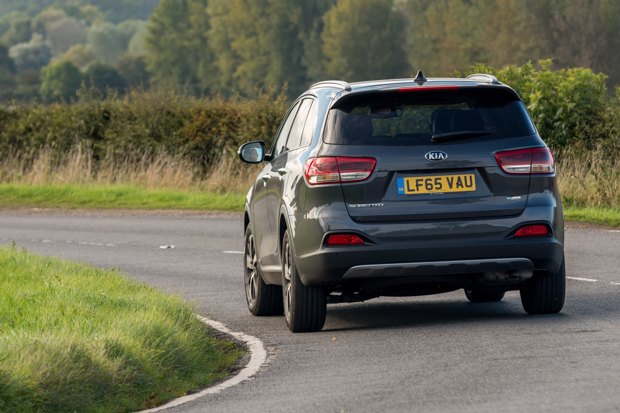
Date: 30 January 2016 | Current mileage 5691 | Claimed economy 46.3mpg | Actual economy 40.4mpg
Last time we reported on the Kia Sorento, there was a problem that had become difficult to live with over 4000 miles. A persistent ringing that kicked in within minutes of setting off on a journey and that was difficult to locate.
I decided to take a passenger who would know where to look for the source of the noise as I drove, and within a few minutes of having John Slavin as a passenger in the rear, he'd tracked down the vibration to the tool kit under floor of the luggage compartment.
The locking wheel nut was slotted into the socket for removing nuts, and as the Sorento was driven, the vibration within a certain rev range resulted in a ringing sound of metal vibrating against metal.
Removing it from the socket and turning it 90º within the polystyrene mould for the tools resolved the issue and the Sorento has carried on dutifully in silence ever since.
One of the most remarkable things I've discovered about the Sorento so far isn't in how it performs on the road, or off it for that matter. According to market analysts, the Sorento holds its value exceptionally well.
CAP Gold Book in February 2016 suggests a residual value forecast of 40 per cent of the Sorento KX-3 at three years/60,000 miles. That's only three percentage points lower than a Porsche Boxster, and four points higher than for a similarly priced Ford Galaxy.
As a car's depreciation forms the basis of monthly payments on a PCP scheme, it means the Sorento should be compeitive against many different types of cars in the same price, including conventional seven-seat MPVs such as the Ford Galaxy, and Volkswagen Sharan.
As we've found typical fuel economy in the low- to mid-40s, that shouldn't fare too badly against those larger MPVs, whose fuel consumption might well be farther removed from the mid-50s suggested by their official combined figure. The Sorento could prove cheaper to run than it appears at first glance.
Two shades of grey
The dull winter weather hasn't been lifted by the Sorento's sober paint colour. But we found out there aren't too many choices.
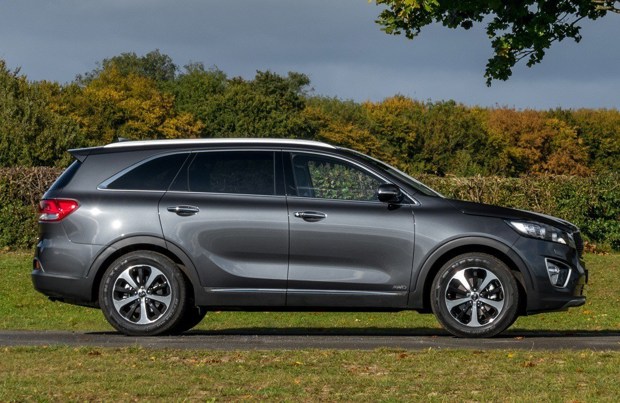
Date: 19 February 2016 | Current mileage 6481 | Claimed economy 46.3mpg | Actual economy 42.8mpg
When the first Kia sorento was launched in 2003, I seem to remember a strong and sophisticated metallic red paint colour in the promotional material. It was a little disappointing to see our test car finished in Graphite Metal (dark grey), and wondered whether there were any alternatives that might have been a little more colourful.
The short answer is no. The choices are restricted to silver (effectively a light grey alternative to our dark grey), black and two whites - one solid and one pearlescent. I can understand focusing on the most popular colours, and the economies of scale of reducing choice (it's much cheaper to produce cars when there are fewer variables in specification), but I expected a few more than five choices (four on the Sorento KX-1)
Looking at other cars of the same size and price bracket as the Sorento, and there is a wider choice. For example, the forthcoming Ford Edge has 10 colour options, including blues, a bronze and red. And looking at Kia's US website, customers across the pond seem to be able to choose a claret and a red metallic.
Hyundai's sister car to the Sorento, the Santa Fe, is available in a total of eight colours, including metallic blues, beige and a red, making me think that Kia's customers are being robbed of choice.
Of course, it could be the case that as this version of the Sorento has been on sale for less than a year, that more colour options could be added later in its lifecycle. But that still doesn't really address the fact that US customers already have more exterior (and interior) colour choices than we do.
It could also be the case that colours are restricted to avoid those that would offer a lower resale value on the used market. White has increased dramatically in popularity over the last 10 years, and the remaining options are 'safe' when it comes to appealing to used car buyers.
One other disappointing feature is the lack of the full active safety package on the KX-3 even as an option. It comes with road-sign recognition, lane departure warning and a rear-view camera for reversing. But the package that includes autonomous emergency braking and blindspot alert if only offered on the range-topping KX-4.
It's a standard feature of that version, but it would be good to see these features made available to models lower down the range. Autonomous emergency braking in particular is increasingly being seen as an invaluable addition, being a be to react to pedestrians suddely stepping out into the road and reducing the risk of injury, as well as helping prevent low-speed damage if the driver fails to respond to a vehicle suddenly braking in front.
How to make the Sorento feel like a sportscar
After a two-week break away from the Sorento it felt like getting behind the wheel of a sportscar. Find out why.
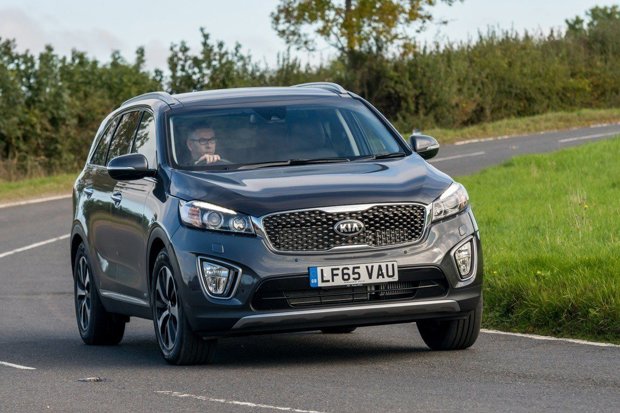
Date: 16 March 2016 | Current mileage 6793 | Claimed economy 46.3mpg | Actual economy 37.1mpg
I'd had a couple of weeks away from the Sorento in other test cars and getting back in this week gave me the remarkable sensation of sitting low, as if it were some high-performance coupé.
Some context: one of the vehicles I'd temporarily given up the Sorento for was a Mitsubishi L200 double-cab, which was part of the Honest John team transport to the Geneva motor show. The L200 is much improved over its predecessors and more than comfortable enough for the 1800-mile round trip, but still has some of the characteristics of a vehicle designed for off-road use and carrying a tonne payload.
The second vehicle was a 4x4 conceived and designed in the 1970s, but updated over the years and still on sale today. The upright, squared stance of the Mercedes-Benz G-Class makes it an oddity in a sector of the market that has evolved along more of road-going bias.
So it was quite a culture shock sitting behind the wheel on Monday in this car that, in broad terms at least, performs a similar role to the previous two I had spent a combined 3000 miles in. The Sorento has four-wheel drive, and will tow up to 2500kg - not as much as the Mitsubishi or Mercedes-Benz, but still substantial.
Although there is a small element of truth linked to the analogy. The current Sorentois 15mm lower than its predecessor, which, along with a wider and longer body, reduces the car's centre of gravity and makes it feel more agile on the road. The power steering motor has also been moved from the steering column to the steering rack to help give the Sorento a more responsive feel.
A longer wheelbase compared with the second-generation model, also helps make it feel more planted on the road, and advanced 'all traction cornering control' increases torque levels to the wheels with the most traction before the electronic stability control has a chance to intervene.
None of this actually makes the Sorento feel like a sportscar, but it certainly gives it a level of stability and tautness that's surprising for a seven-seat 4x4, and it's certainly noticeable when driving it after a spell in 4x4s with more primitive origins, including the second-generation Sorento.
So far, there hasn't been an opportunity to test the Sorento's off-road credentials, nor even give the four-wheel drive system a traction tesrt as our winter has been relatively mild. But I'm planning to put that right before the car is returned to Kia in a couple of months.
The trouble with technology
The Sorento isn't short of gadgets. But we've found one or two could be more trouble than they're worth.
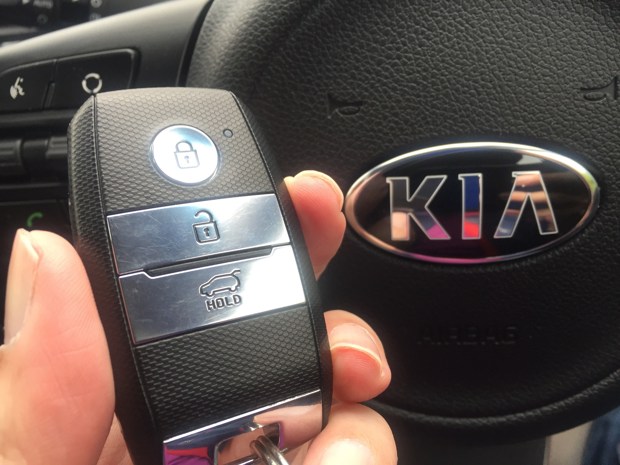
Date: 17 May 2016 | Current mileage 10,215 | Claimed economy 46.3mpg | Actual economy 39.7mpg
The Kia Sorento in KX-3 specification has plenty of standard equipment. There's a full-length glass roof with opening sunroof; it has heated seats front and rear; it has DAB and touch-screen sat-nav.
In fact with the exception of the extra safety equipment only available on the range-topping KX-4 model, it's got pretty much everything. The only 'blanks' on the dashboard are for ventilated front seat switches, which are available on the KX-4.
It even has a power tailgate, which will not only open and close itself at the push of a button, it's possible to open it when standing near itif you stay still for long enough. This is all brilliant while it works. But a number of times I've gone out to the car to find the tailgate wide open.
My neighbours knocked the door once to remind me to close it after bringing in my weekly shop. I hadn't been shopping. Another time I went out to it one morning after parking it in front of the garage to find the tailgate reaching out to the garage door. Judging by the tiny footprints inside the car, it was enough of a temptation to lure a local cat inside to look around. Fortunately, the cat chose not to leave any 'presents' inside.
It's easily prevented if you go into the car's settings and disable the power tailgate, but it's difficult to know what caused it to happen. However, I have my suspicions.
The Sorento's keyfob is large and flat without any recesses. I usually carry the key in my left trouser pocket, along with my house key. I think that if I crouch to look in a low kitched cupboard at home, there's a chance my house key or a small LED keyring attached is pressing against the Kia keyfob and activating the power tailgete.
Although when it's about to open or close a short beeping alert is heard to warn people standing nearby of ts impending movement, but indoors it would be impossible to hear. Unfortunately it's still close enough to activate it with the key.
Now I don't think keeping a car key in my pocket during the day is unusual behaviour (although some have disputed this with me), and I believe that if this flat keyfob is too easily activated, a remedy needs to be designed in future models.
All the car you'll ever need?
When some motoring publications profess that some high-performance estate car or other is 'all the car you'll ever need', they're missing some very important customers.

Date: 25 May 2016 | Current mileage 10,510 | Claimed economy 46.3mpg | Actual economy 41.1mpg
I must had read dozens of times on Twitter and in journalists' reports on driving some high-performance estate, that this remarkable vehicle is 'all the car you'll ever need'. This is, of course, utter nonsense.
The supposition completely ignores the need, which may be occasional, to carry more than five people. Sometimes a car owner might need to tow, whether a trailer, a caravan or maybe a horsebox. Some high performance cars have zero towing capacity (even fast versions of mainstream cars) because the manufacturers figure people will choose something more suited to that purpose.
Then there's all-wheel drive ability - perhaps in some cases you'll need to tow something across a muddy field while carrying more people than a traditional car will take. So what is 'all the car you'll ever need'?
It probably looks something like the Kia Sorento. Seven seats and all-wheel drive come as standard, and it will tow up to 2500kg. You might not choose it for the reasons you'd be coveting a high-performance car but over the last six months I've never once wished the Sorento was any quicker than it is.
Sorento can tow a big old caravan. Do fit it with a towbar first though...
With 441Nm of torque available from 1750rpm, the Sorento is hardly ever caught out when you need a quick burst of acceleration when joining a motorway or overtaking. It's handling and responsiveness are surprisingly deft for such a large and tall vehicle. You get the impression that Kia really has got the hang of producing SUVs and keeps adding highly competitive models to its line-up.
The Sorento isn't perfect. Over the last six months there have been a few little irritations, but overall it's an excellent car, and it's easy to see why families who used to be satisfied with seven-seat MPVs are now gravitating toward cars like the Sorento.
You'll probably find it's a lot cheaper to run than a high-performance car, too. We've routinely achieved more than 40mpg against an official combined figure of 46.3mpg. It never looked like threatening to exceed the stated figure, but it's a reliable low 40s unless you spend a lot of time around town.
The Sorento also has a strong resale value. Early in our appraisal we discovered it had been on a par with the Porsche Boxster, and a strong resale value usually means very attractive monthly payments on PCP schemes. The Sorento has been an excellent companion over last six months, with so many rational reasons for choosing one that have been validated living with the car.


